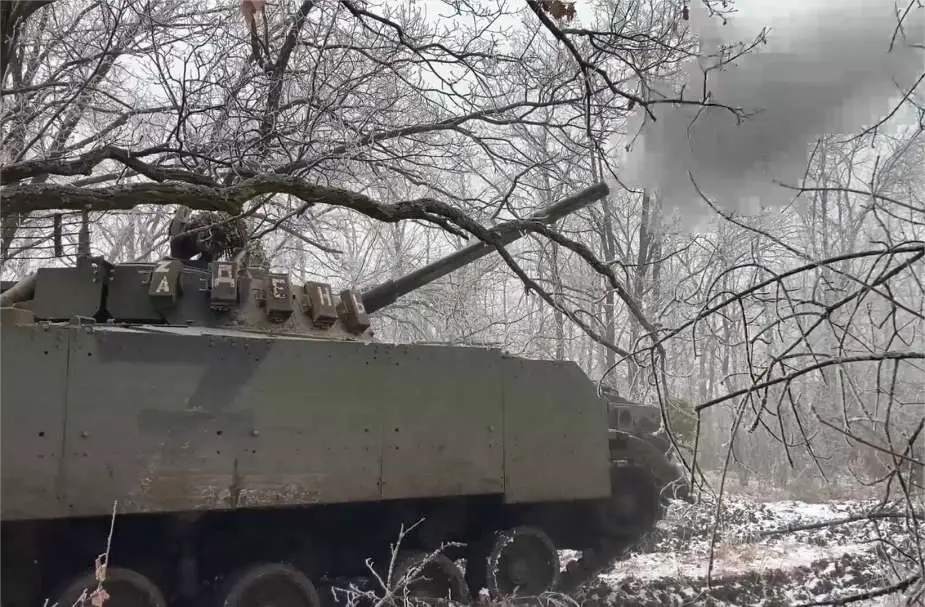Russia's BMP-3 role in Ukraine is shifting to indirect fire support vehicle
As reported by the Russian Ministry of Defense on January 22, 2024, servicemen from the Russian 1st Guards Tank Army have begun using their BMP-3 Infantry Fighting Vehicle (IFV) to support infantry units in the Kupyansk direction, utilizing both indirect and direct fire positions. This shift towards employing indirect fire tactics by Russian BMP-3 crews can be attributed to vulnerabilities exploited by Ukrainian forces during close assault operations near their positions.
Follow Army Recognition on Google News at this link

This shift towards employing indirect fire tactics by BMP-3 crews can be attributed to vulnerabilities exploited by Ukrainian forces during close assault operations near their positions. (Picture source: Russian MoD)
The commander of the BMP-3's crew, known as Vekt, outlined their primary tasks, which involve supporting infantry units through both indirect and direct fire positions, targeting enemy infantry, light fortifications, and mortars. These tactics appear to aim at reducing exposure to direct enemy fire and counter-battery attacks, ensuring the safety of both the crew and the vehicle.
Recent reports indicate that BMP-3 crews are increasingly adopting these indirect fire and long-range tactics in combat, particularly in areas like Bakhmut, where they engage enemy infantry and fortified positions of the Ukrainian Armed Forces from concealed positions at distances exceeding four kilometers. An armored group commander known as "Sych" revealed a record engagement distance of 4 kilometers and 260 meters. According to him, BMP-3 units are always prepared to support infantry units with two additional ammunition loads on standby, ensuring rapid response times.
The BMP-3's use in indirect fire positions offers tactical advantages for Russian soldiers, primarily attributed to its 2A70 100mm gun, capable of firing both conventional projectiles and guided missiles. Employing these positions reduces exposure to direct enemy fire and counter-battery attacks, enhancing the safety of the crew and the vehicle. Indirect fire tactics can lead to unexpected engagements, thanks to the BMP-3's low acoustic profile, potentially catching the enemy off guard and reducing their reaction time. Its extended range capability enables support from a distance, mitigating risk while maintaining a stealthy approach. Operating from such positions maximizes terrain advantages for concealment and protection, providing combat flexibility by allowing the BMP-3 to switch between direct and indirect fire modes to effectively engage a wide range of targets.
This tactical shift likely stems from the effectiveness of Ukrainian forces in targeting and destroying Russian BMP-3 IFVs using various methods in close-combat scenarios. These methods include the use of Stugna anti-tank guided missiles and FPV kamikaze drones, which have demonstrated the ability to overcome additional improvised armor defenses on BMP-3s, such as explosive reactive armor (ERA) and slat-armor screens. Ukrainian forces' adaptability and capability to engage and neutralize Russian armored assets in close-combat operations are evident, as seen by the increased use by Russian soldiers of improvised additional armor and drone jammers.
The conflict in Ukraine has seen intense artillery exchanges, resulting in significant casualties on both sides. Russia has faced challenges due to the depletion of its artillery stocks, impacting its operational capabilities. As a response, there have been efforts to develop new artillery systems, adapt naval weaponry for ground combat operations, and use vehicles originally intended for close combat support as mobile long-range artillery units. These actions suggest a pressing need to replenish lost equipment and maintain artillery capabilities to exert sustained pressure on opposing forces. This need is further highlighted by the deployment of older equipment like the BTR-50 APC, the T-55 tank, and even museum pieces such as the BTR-90.
The BMP-3 itself is an infantry fighting vehicle equipped with a 100mm rifled gun, a 30mm dual-feed autocannon, and a coaxial 7.62mm machine gun. Its advanced fire control system, including an autoloader for the main gun and a ballistic computer, enables precise targeting under various conditions. With a UTD-29 diesel engine providing 500 horsepower, the BMP-3 offers mobility on both land and water, with a range of 600 kilometers. Its armor provides protection against 30mm armor-piercing rounds, and additional features like smoke grenade launchers and explosive reactive armor enhance its defensive capabilities.





























